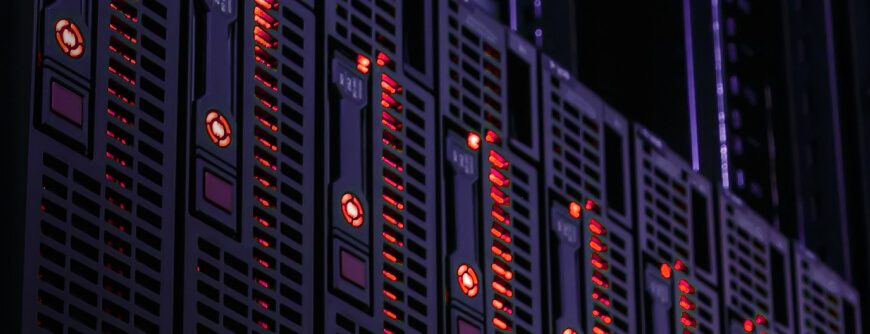Em um ambiente de alta velocidade e alta capacidade, como um datacenter na nuvem, os administradores têm imóveis finitos para se adequar ao hardware. Um servidor blade minimiza o espaço necessário para hospedar milhares de servidores fornecendo uma máquina física compacta que pode caber em um rack. Um rack pode comportar vários servidores blade e é instalado em um rack. Os servidores compactos trabalham juntos para fornecer serviços de computação de alta potência para empresas.
O que é um servidor blade?
Em um ambiente de datacenter, os administradores precisam instalar o máximo de servidores possível. O termo “lâmina” é usado para descrever servidores muito finos e pequenos que se encaixam em “bays” e se conectam para realizar computação de alta potência. As baias estão em um contêiner semelhante a uma caixa (chassi) que pode caber em até oito lâminas. O rack pode ser instalado em um rack localizado no datacenter. Com essa configuração, você pode instalar dezenas de servidores em um rack.
Como os blades são servidores individuais, eles contêm os componentes básicos de hardware que compõem uma máquina, como CPU, memória, controladores de rede e portas de entrada e saída. Vários blades são conectados usando fibra para que os dados possam ser compartilhados rapidamente entre servidores e a rede.
Quais são os componentes de um servidor blade?
O hardware incluído com um servidor blade depende do fabricante, mas a maioria das máquinas vem com componentes básicos comuns. O servidor tem o básico para ser executado sem ter um servidor individual grande que ocupa muito espaço. A máquina compacta contém uma CPU, memória e componentes para manter a máquina fria (por exemplo, um dissipador de calor).
As unidades com hot-swap podem ser instaladas em muitos servidores blade, mas você também pode usar o armazenamento anexado à rede (NAS ) ou uma rede de área de armazenamento (SAN ) para hospedar arquivos para o servidor blade usar. Ele também contém controladores de rede e uma interface para se conectar à rede local.
As blades se conectam a um rack, que é a parte externa que mantém vários servidores blade juntos. O rack se conecta a um gabinete de rack. O número de racks que cabem em um rack depende do tamanho do rack e do tamanho de cada rack. Normalmente, o rack também deve ter espaço para os cabos que se conectam aos servidores blade.
Como funciona um servidor blade?
Em uma configuração tradicional de servidor único, uma empresa tem um servidor que gerencia serviços de computação. Na nuvem, os administradores podem aproveitar vários servidores sem o custo de hospedar o hardware localmente. Um servidor blade é um servidor individual, mas vários servidores blade trabalham juntos para combinar sua capacidade computacional para executar funções como executar aplicativos de usuário. Cada servidor blade seria responsável por um aplicativo, mas os servidores podem compartilhar dados pela rede.
Um benefício dos servidores blade em relação aos servidores rack é que os servidores blade são mais compactos, para que você possa ajustá-los mais em um único rack e rack de servidor. Os servidores blade contêm o mínimo de componentes para serem executados com eficácia, mas ainda produzem calor que deve ser removido do ambiente.
Cada blade contém um único servidor, mas vários blades podem ser contidos em um único rack. As empresas que alugam servidores blade geralmente alugam vários por vez para dar suporte a aplicativos críticos, mas esses servidores são muito modulares. Você pode mover servidores blade entre datacenters usando recursos hot-swap sem desligar todos os servidores blade em um cluster.
Razões para usar um servidor blade
Se você precisa de vários servidores, mas não tem espaço para alojá-los, um servidor blade é uma boa opção. Cada blade é um único servidor, e esses blades se encaixam em uma pequena área. Usando serviços de nuvem, você pode alugar servidores blade sem instalá-los no seu espaço de escritório físico local. No entanto, os administradores de datacenter ainda precisam instalá-los no local.
Os servidores blade são a capacidade de computação mais compacta que você pode obter, por isso normalmente fazem parte da capacidade de computação corporativa para dar suporte a aplicativos críticos que precisam de velocidades rápidas para atender milhares de usuários. Se você decidir mover seus servidores blade, eles são hot-swap e não exigem que os administradores desliguem todo o sistema para movê-los. Os principais benefícios dos servidores blade são:
- São modulares e intercambiáveis
- Oferece capacidade de computação de alta velocidade
- Suporte a serviços populares da Web, como streaming, cache da Web e virtualização
- Forneça serviços em cluster com balanceamento de carga e failover
Razões para não usar um servidor blade
Se você tem uma pequena empresa e deseja hospedar serviços no local, talvez não precise gastar dinheiro em servidores blade, o que pode ser mais caro do que um servidor autônomo padrão. Se sua organização puder executar serviços simples no local ou na nuvem, talvez não seja necessário usar um servidor blade.
Usando serviços de nuvem, você não precisa se preocupar com a manutenção envolvida com servidores blade. O gerenciamento de calor e umidade é importante ao abrigar qualquer equipamento de computação, incluindo servidores blade. Se quiser alojar equipamentos de computação, você precisa dos controles corretos de calor e umidade para manter adequadamente o ambiente do servidor. Sem ele, você não deve instalar servidores blade localmente.
Conclusão
Os servidores blade são compatíveis com virtualização para que você possa usá-los em um ambiente de nuvem. Os tipos de servidores oferecidos por um provedor de nuvem dependem do serviço que você aproveita, então você pode já estar usando servidores blade na nuvem. Se você precisa especificamente de servidores rápidos e compactos, um servidor blade pode ser usado para fornecer aplicativos rápidos e dar suporte a milhares de usuários.



